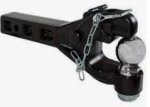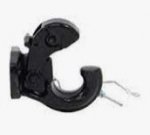Alloy
Well-known member
More credible discussion:
I've fixed/replaced tow ball mounts/hitch pins that people assumed were OK.
Best practice would be to use all his own gear.
Last edited:
More credible discussion:
Help offered has to be up to but not exceed your level of training, experience and trust in equipment (both yours and theirs). I suppose the experience part is key to knowing level of risk, since there's never going to be zero risk. It's a go/no-go assessment. There's got to be times when you're not the appropriate person or truck to do anything other than offer to try calling on ham or in the case of a real issue pushing SOS on an InReach or SPOT maybe.Here's another way to look it it:
I'm sorta willing to have any catastrophic failures launch metal at you or your vehicle, but not at me or mine.
This is one of the reasons I carry both hard and soft shackles, etc. If you've asked me for help, but between the two of us I can't find a way to rig the snatch out that doesn't involve the risk of debris launched in my direction, then my "help" is going to be limited to me lending my comms equipment for you to call for someone better equipped.
That is great in theory but only works if you have a really large receiver tube or a really small strap...Hopefully we aren't using really small straps ?Pull the receiver pin, remove the draw bar, insert the loop of the strap and then put the pin back so that it catches the loop of the strap.
You might be able to bend the pin, but I doubt it. You will remove the danger of the flying tow ball.








A grade-5 3/4" fastener should be a minimum of 25,290 lbf in shear and a 1.125" would be 51,143 lbf. I don't think tow hardware is rated any higher than grade-5. You might be on to something noticing that a tow point isn't always just a tow point.Not to be Freudian but balls are balls but the size of the shaft will have a larger impact on any failure. I have seen tow balls with 3/4" shafts and others with 1 1/8" shafts. FWIW just because you've seen it done doesn't mean it's safe IMHO.
Interesting point regards to pintle-ball combo. I don't know but one difference might be that the top arm will support the ball so it doesn't tip into tension and stays more completely in shear? I know many people trust pintle hooks (I would personally) but I don't know that anyone's ever suggested that is founded or misplaced. The gotcha I have mainly revolves around the bolts themselves and the risk of them pulling through the frame member.Just to complicate matters, I suppose everyone thinks a pintle hitch would be a good recovery point? What about a combination pintle/ball hitch? What about receiver mounted or bolted?
Also Australia has 99% bolted balls, Europe has the ball and shaft forged as one piece (much as a forged hook?).
Personally I believe it is all a matter of weight rating and condition check...
Depending on rope/strap ,although it was their attachment point it, it may end up in/on/thru your vehicle.I will pull from the pintle if I am able to go forwards, but it is a full pintle not a ball pintle.
I tell whoever I am pulling to be happy with their attachment point because whatever they attach to is coming out!
the duct tape paint protection is my favorite.
the duct tape paint protection is my favorite.
any professional extractor Only uses "spec-grade" assembly tape. jump to 01:24 for reference:
